Mar 08, 2016
No traction for climate change; Study Shows How Climate Science Could Be All Wrong
Thomas Pyle
Tom Steyer’s priorities are at odds with America
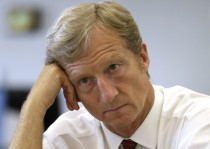
To be fair, Mr. Steyer does appear to hold sway over the Democratic presidential candidates. Both Hillary Clinton and Bernie Sanders have, at Mr. Steyer’s insistence, pledged to achieve at least 50 percent “clean” energy by 2030. Mr. Steyer, who has yet to throw his support behind a candidate, appears to be dangling his wealth and endorsement over the Democratic candidates to cajole them to do even more.
Just days before the New Hampshire primary, Mrs. Clinton was asked if she would support banning the extraction of natural gas, oil, and coal on public lands. “Yeah, that’s a done deal,” was her reply. Clarifying her position to another activist, she said, “No future extraction. I agree with that. “Similarly, Mr. Sanders has co-sponsored legislation in the Senate that would block the development of these resources on federal lands. According to a recent study commissioned by the Institute for Energy Research, of which I am president, these “keep it in the ground” proposals would forgo millions of jobs, trillions of dollars in higher wages, and $20.7 trillion in economic activity.
Fortunately, on the whole, Mr. Steyer’s campaign to restrict affordable and reliable energy isn’t getting many converts. Mr. Steyer spent $73.7 million of his own money in a failed effort to make climate change a major issue in the 2014 elections. He wasted millions of dollars on ads that often didn’t even address climate change and whose truthfulness was disputed by fact-checking organizations like Poltifact and Factcheck.org. After his nearly yearlong campaign, climate change actually dropped as a priority among voters, ending up near the bottom of their list of concerns.
Mr. Steyer shouldn’t be entirely surprised if presidential hopefuls aren’t jumping through his hoops with enthusiasm. In a recent Gallup poll of the most important problems facing the United States, climate change was not even listed. The broader “Environment/Pollution” was in 18th place as a concern of just 2 percent of the respondents. The political reality is that candidates must attract the mainstream electorate, who prioritize the economy, jobs and poverty - issues that are in direct conflict with Mr. Steyer’s goals.
Mr. Steyer’s own state of California is ripe with examples of his agenda clashing with the people’s needs. Due in part to regulations that require non-hydroelectric renewables to represent 33 percent of the state’s electricity supply by 2020, residential electricity bills are nearly 40 percent higher than the national average and the ninth highest in the nation. Nevertheless, last year, Mr. Steyer testified in favor of legislation that would have bumped the current 33 percent renewables target up to 50 percent by 2030.
Mr. Steyer also supports California’s cap-and-trade program, which could raise gasoline prices by anywhere from 16 cents to 76 cents per gallon. Meanwhile, he’s pushing a ballot measure that would impose a 10 percent tax on oil extraction. This tax would, of course, raise gasoline prices for the state’s motorists, who already pay a 59 cents per gallon gas tax - one of the nation’s highest and about 11 cents more than the national average. Even without new taxes, California already has some of the highest gasoline prices in the country.
Higher energy costs have created a serious problem in California. According to a report by the Manhattan Institute, one million California households live in energy poverty, which is defined as a household in which 10 percent or more of the residents’ income is spent on household energy costs (excluding gasoline and other transportation-related costs). Higher energy costs leave these families with less money to spend on other necessities like groceries or proper healthcare.
Candidates seeking the presidential nomination - particularly in the Democratic camp - can’t square their rhetoric with their policies. They claim to help the poor, but they support energy policies that will make it harder for low-income families to make ends meet. Meanwhile, poll after poll shows Americans are more concerned about growing the economy and creating jobs than sacrificing their economic futures at the altar of Tom Steyer’s climate agenda.
* Thomas J. Pyle is the President of the American Energy Alliance.
-----------
See Chuck Wiese’s very rigorous proof that a warming arctic can’t cause increased severe weather and temperature extremes here.
---------
CAPITAL HILL IBD
A New Study Shows How Climate Science Could Be All Wrong
By John Merline
What could the theory of “ego depletion” possibly have to do with global warming?
Ego depletion is the idea in psychology that humans have a limited amount of willpower that can be depleted. It’s been largely accepted as true for almost two decades, after two psychologists devised an experiment in self-control that involved fresh-baked cookies and radishes.
One group of test subjects were told they could only eat the radishes, another could eat the cookies. Then they were given an unsolvable puzzle to solve. The researchers found that radish eaters gave up on the puzzle more quickly than the cookie eaters. The conclusion was that the radish eaters had used up their willpower trying not to eat the cookies.
Daniel Engber, writing in Slate, notes that the study has been cited more than 3,000 times, and that in the years after it appeared, its findings “have been borne out again and again in empirical studies. The effect has been recreated in hundreds of different ways, and the underlying concept has been verified via meta-analysis. It’s not some crazy new idea, wobbling on a pile of flimsy data; it’s a sturdy edifice of knowledge, built over many years from solid bricks.”
But, he says, it “could be completely bogus.”
A “massive effort” to recreate “the main effect underlying this work” using 2,000 subjects in two-dozen different labs on several continents found ... nothing.
The study, due to be published next month in Perspectives on Psychological Science, “means an entire field of study - and significant portions of certain scientists’ careers - could be resting on a false premise.”
Engber laments that “If something this well-established could fall apart, then what’s next? That’s not just worrying. It’s terrifying.”
Actually, it’s science.
As Thomas Kuhn explained in his 1962 book “The Structure of Scientific Revolutions,” this kind of event is typical in the course of scientific progress.
A “paradigm” takes hold in the scientific community based on early research, which subsequent studies appear to confirm, but which can later collapse as findings that don’t fit the paradigm start to accumulate. Kuhn found several such “paradigm shifts” in history.
The ego depletion findings also come as scientists are starting to realize that much, if not most, of what gets published is essentially bogus because it can’t be reproduced by subsequent studies.
“By some estimates,” notes an article in Quartz, “at least 51% - and as much as 89% - of published papers are based on studies and experiments showing results that cannot be reproduced.”
The Quartz article says one reason is a bias in scientific journals to produce “exciting studies that show strong results.”
“Studies that show strong, positive results get published, while similar studies that come up with no significant effects sit at the bottom of researchers’ drawers.”
So what does any of this have to do with global warming?
Democrats routinely accuse Republicans of being “anti-science” because they tend to be skeptical about claims made by climate scientists - whether it’s about how much man has contributed to global warming, how much warming has actually taken place, or scary predictions of future environmental catastrophes.
There’s a scientific consensus, we’re told, and anyone who doesn’t toe the line is “denier.”
Yet even as deniers get chastised, evidence continues to emerge that pokes holes in some of the basic tenets of climate change.
Evidence such as the fact that actual temperature trends don’t match what climate change computer models say should have happened since the industrial age. Or that satellite measurements haven’t shown warming for two decades. Or that past predictions of more extreme weather have failed to come true.
It is certainly possible then, that today’s climate change paradigm - and all the fear and loathing about CO2 emissions - could one day end up looking as quaint as Ptolemy’s theory of the solar system or Galen’s theory of anatomy.
It’s possible. And anyone who believes in science has to admit that.
Mar 04, 2016
Comments on New RSS v4 Pause-Busting Global Temperature Dataset
Dr. Roy Spencer
Now that John Christy and I have had a little more time to digest the new paper by Carl Mears and Frank Wentz ("Sensitivity of satellite derived tropospheric temperature trends to the diurnal cycle adjustment”, paywalled here), our conclusion has remained mostly the same as originally stated in Anthony Watts’ post.
While the title of their article implies that their new diurnal drift adjustment to the satellite data has caused the large increase in the global warming trend, it is actually their inclusion of what the evidence will suggest is a spurious warming (calibration drift) in the NOAA-14 MSU instrument that leads to most (maybe 2/3) of the change. I will provide more details of why we believe that satellite is to blame, below.
Also, we provide new radiosonde validation results, supporting the UAH v6 data over the new RSS v4 data,
While Carl and Frank have yet to provide a new analysis of the most popular Lower Troposphere (LT) temperature product, their new analysis for the Mid-Troposphere (MT) has greatly increased their reported warming trend, which used to be very close to ours:

RSSv4-vs-UAH-MT-original-series
If we plot the difference between the two curves, we see more clearly where the discrepancies between the two datasets arise:
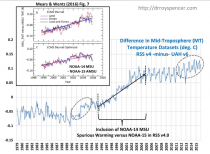
RSSv4-vs-UAH-MT-original-series
Here I have included their Fig. 7 as an inset to show that they know there is a substantial trend difference between the old NOAA-14 MSU and the newer NOAA-15 AMSU measurements. That trend difference amounts to +0.20 C/decade...a large discrepancy.
Importantly, Mears and Wentz choose to leave this calibration drift in without adjustment for it. In effect they are saying, ‘we don’t know which of the two satellites is at fault, so we will leave both satellites in without adjustment’.
Here are the reasons why we believe we can blame the calibration drift on the NOAA-14 MSU instrument, and why we remove that spurious warming from the NOAA-14 data in our v6 LT and MT products:
(1) the old MSU instruments’ calibration did not have near the sophistication of the newer AMSU instruments (NASA AMSU design engineer Jim Shiue once told me the AMSUs had “Cadillac"-quality calibration)
(2) the NOAA-14 satellite orbit was drifting far beyond any of the other dozen satellites in the record, leading to warming of the instrument itself (which is why we cut the record short after 6 yrs, RSS uses all 10 years), while the NOAA-15 satellite had very little orbital drift during its overlap with NOAA-14.
We find it curious (to say the least) that RSS would treat these two satellites as equally accurate.
About a third of the trend difference appears to be due to a change in the RSS method for diurnal drift adjustment, as indicated by the dashed ovals in the second plot, above. (Diurnal drift is the result of the satellite overpass time changing over the years, so that measurements are made at a different times of day; over land in particular this causes a drift in measured temperature due to the day-night cycle, not climate). Their new adjustment appears to provide a stronger correction for the diurnal cooling of the NOAA-11 satellite (first oval) and the NOAA-18 satellite (second oval). RSS uses the diurnal cycle from a climate model (CCM3), with empirical adjustments. We (UAH) use a pure empirical adjustment based of the the observed drift between NOAA-18 and NOAA-19 (for the “1:30” satellites) and NOAA-15 and Aqua (for the “7:30” satellites).
Details of our diurnal drift adjustments (now submitted for publication) were discussed here; for example, here are the diurnal drift coefficients (deg. C/hr) used during June:
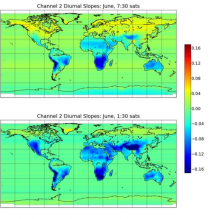
RSSv4-vs-UAH-MT
Radiosonde and Reanalysis Comparison
After Carl made the new RSS data available to us, John Christy computed the level of agreement (explained variance) that three satellite datasets (RSSv4, UAHv6, NOAAv3.0) have with the corresponding values from various radiosonde and reanalysis datasets. The results indicate that, with the exception of one reanalysis dataset (MERRA-2, which has by far the warmest trend), the UAH anomalies have better agreement with other data sources than does the RSS (or NOAA) dataset:
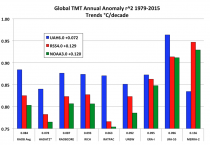
GL_MT_r2_vs_roab_and_reanalysis
Regarding the NOAA-14 period in particular, John also computed the change in global average temperature between two 5 yr periods, 1990-94 versus 2003-2007, in both the radiosonde data (average of RICH, RAOBCORE, RATPAC, UNSW) and the satellite data. The results suggest that there is spurious warming in the RSS product over this time period:
2003-07 minus 1990-94 MT, Global
UAH_v6: +0.16 deg. C
RAOBav: +0.16 deg. C
RSS_v4: +0.28 deg. C
Conclusion
The evidence suggests that the new RSS v4 MT dataset has spurious warming due to a lack of correction for calibration drift in the NOAA-14 MSU instrument. Somewhat smaller increases in their warming trend are due to their use of a climate model for diurnal drift adjustment, compared to our use of an empirical approach that relies upon observed diurnal drift from the satellite data themselves. While the difference in diurnal drift correction methodolgy is a more legitimate point of contention, in the final analysis independent validation with radiosonde data and most reanalysis datasets suggest better agreement with the UAH product than the RSS product.
Update (4 March 12:35 p.m.)
Chip Knappenberger has pointed out that, while the warming in RSS v4 versus UAH v6 might be as described above, when RSS v4 is compared to RSS v3.3, the increase in warming might be mostly due to their new diurnal cycle adjustment. In other words, the NOAA-14 calibration issue was also in their v3.3, but maybe it was obscured more by diurnal drift adjustment issues.
Feb 24, 2016
Global Warming and the Irrelevance of Science
By Dr. Richard Lindzen
Extracts from the insightful text of lecture delivered on August 20, 2015 to the 48th Session: Erice International Seminars on Planetary Emergencies by Richard S. Lindzen, Alfred P. Sloan Professor of Atmospheric Sciences, Emeritus Massachusetts Institute of Technology.
In many fields, governments have a monopoly on the support of scientific research. Ideally, they support the science because they believe objective research to be valuable. Unfortunately, as anticipated by Eisenhower in his farewell speech from January 17, 1961 (the one that also warned of the military-industrial complex),
“Partly because of the huge costs involved, a government contract becomes virtually a substitute for intellectual curiosity.”
Under these circumstances, when the government wants a particular scientific outcome the ideal arrangement is vulnerable. However, as I hope to show, the problem is not simply bias.
Rather, the powers that be invent the narrative independently of the views of even cooperating scientists. It is, in this sense, that the science becomes irrelevant. This was certainly the case in the first half of the twentieth century, where we just have to look at Lysenkoism in the former Soviet Union, Social Darwinism, and Eugenics throughout the western world, as well as, in the 1960s, the unfounded demonization of DDT. Each phenomenon led to millions of deaths. And, in each case, the scientific community was essentially paralyzed, if not actually complicit.
Will climate catastrophism join this list? It appears so. The position of the policy world is clear.
Here is President Obama’s constant refrain:
“Climate change is contributing to extreme weather, wildfires, and drought, and that rising temperatures can lead to more smog and more allergens in the air we breathe, meaning more kids are exposed to the triggers that can cause asthma attacks.”
Pope Francis, President Hollande, and virtually all state leaders have chimed in with similar proclamations. And yet, the whole proposition is largely without basis and highly implausible. The association with asthma that is regularly made by both Obama and Hillary Clinton is a good example of nonsense driven by focus groups who find this to be an effective scare theme. The other claims are no better.
Of course, some political figures skip any embarrassing pretenses concerning science and move directly to their agenda. Christiana Figueres, executive secretary of U.N.’s Framework Convention on Climate Change:
“This is the first time in the history of mankind that we are setting ourselves the task of intentionally, within a defined period of time, to change the economic development model that has been reigning for at least 150 years, since the Industrial Revolution.”
Ms. Figueres is not alone in taking this approach. Pope Francis’ closest adviser castigated conservative climate change skeptics in the United States, blaming capitalism for their views.
Speaking with journalists, Cardinal Oscar Rodriguez Maradiaga criticized certain “movements” in the United States that have preemptively come out in opposition to Francis’s planned encyclical on climate change.
“The ideology surrounding environmental issues is too tied to a capitalism that doesn’t want to stop ruining the environment because they don’t want to give up their profits.”
It is difficult to know whether the statements of prominent political figures represents dishonesty, ignorance or both. Ms. Figueres may be the most honest. No proposed measures will have any discernible impact on climate (regardless of one’s view of the physics) unless one rolls back the industrial revolution everywhere and permanently - and even then significant impact on global climate is dubious. Of course, no country outside the western world would even consider this, though they are perfectly happy to endorse the efforts of the West to do so.
A constant feature of the public presentation of the issue is the exploitation of public ignorance. A large poster appearing in the Paris Metro showed the World Wildlife Fund’s signature panda leading young people in mass demonstration (intentionally mimicking the storming of the Bastille) calling for the elimination of CO2. Presumably these young people have never heard of photosynthesis and fail to realize that advanced forms of life would largely cease for levels of CO2 less than about 150 ppmv (we are currently 400 ppmv).
It is clear that the issue of climate does constitute an emergency. However, as is so often the case, the emergency does not arise from science and technology, but rather from politics. It is worth examining whether science can play a role in the mitigation of this emergency. It is doubtful whether the answer will consist in research grants. However, science has much at stake. Its hard earned raison d’etre as our most effective tool for objective assessment is being squandered, and with it, the basis for public trust and support.
If we do nothing to stop this insanity, science will rightly be regarded as just another racket.
This might just be more collateral damage than we can readily afford.
Feb 21, 2016
Remember the Climate!
Paul Driessen
President Obama continues to insist that climate change is the gravest threat facing our nation. He has even ordered the Defense Department and all branches of our military services to include climate change analyses in their combat planning, training exercises, intelligence gathering, weapons testing and procurement, fuel types and uses, and practically every other aspect of military operations. It is sheer lunacy - befitting a Gilbert and Sullivan parody, right out of The HMS Pinafore.
My article this week examines WHY this is such a colossal mistake - and why reliance on climate models is so misplaced.
Thank you for posting it, quoting from it, and forwarding it to your friends and colleagues.
Best regards,
Paul
Remember the Climate!
Obama orders Pentagon, generals and admirals to make climate change Job One
Paul Driessen
Military triumphs and catastrophes have often hinged on how well (or luckily) armies and navies employed, avoided or benefited from weather and other natural events. Severe storms helped the British navy defeat Spain’s Armada in 1588. George Washington knew horrid weather meant the Hessians would not expect an attack across the Delaware River on Christmas 1776.
Napoleon captured Moscow before leading his Grande Armee’s exhausted, starving, freezing remnants back to France through a bitter 1812 Russian winter. Hitler’s army never even reached Moscow; it was decimated by disease, starvation, bullets and frigid cold at Stalingrad 140 years later.
Eisenhower’s Normandy invasion plans anticipated a full moon that would illuminate bomber targets and bring low tides to expose German mines and obstacles along the beaches. Instead, overcast skies limited Allied air support - but persuaded the Nazi high command that no invasion would occur for several days. So senior officers stayed in Germany, leaving their army unprepared for D-Day, June 6, 1944.
Throughout history, commanders discovered that trying to predict the weather - or their enemies’ resolve = was fraught with peril. Even today, accurate weather forecasting is a highly uncertain science, even a few days in advance, especially for hurricanes or winter blizzards in Mid-Atlantic states where winds, storm tracks, temperatures and moisture are affected by the Atlantic Ocean, Gulf of Mexico and Arctic.
But now President Obama wants to compound his social experimentation with the military, by ordering the Pentagon brass to focus not on imminent weather events surrounding battle plans - not on threats from China, Russia, Iran, North Korea, ISIL, Hamas and other real hot spots but on climate change years or decades in the future. He wants to replace Remember the Alamo with Remember the Climate!
Mr. Obama has issued an executive order directing the Department of Defense (and all other federal government agencies) to make preparing for global warming impacts a top priority, and treat climate change as our most serious national security threat. He even warned 2015 Coast Guard Academy graduates that denying” climate change is a “dereliction of duty.” You can’t make this stuff up.
The EO directs the Pentagon to order all military commanders, down to battle planning levels, to include climate change analyses in combat planning, training exercises, intelligence gathering, weapons testing and procurement, fuel types and use, and practically every other aspect of military operations. This could include restrictions on the type and duration of training flights, amphibious landings and tank maneuvers.
It is sheer lunacy. It means bureaucrats and new layers of armed forces bureaucracies will waste time and money, and ignore real weapons and training issues. It means soldiers and sailors must now focus less on real natural and humanitarian disasters, and more on climate refugee crises that exist only in computer models, ivory tower studies and White House press releases. It could affect combat readiness and morale, make our warriors less prepared for warfare, and put them at greater risk of injury and death.
Other Obama orders forced the Air Force to spend $59 a gallon for “renewable” jet fuel and $67 per gallon for camelina-based F[22 Raptor fuel - and the Navy to spend $27 per gallon for biofuels from algae, waste grease and animal fat, and $424 a gallon for 20,000 gallons of “sustainable” diesel fuel. All that when conventional gasoline, diesel and jet fuel sell for $2.00-$3.50 per gallon (thanks to fracking)!
Like the other social experiments, this is being imposed by political operatives with little or no military service, few kids in the military, and minimal concern about how these policies, multiple deployments and stretched-to-the-breaking-point budgets might affect military readiness, morale, safety and families.
Even more absurd, the orders are based on pseudo-science and indefensible assumptions that carbon dioxide now drives climate change, and we have the knowledge and ability to predict climate shifts, extreme weather and related disasters years or decades in advance. Basing defense policies on these notions is ridiculous and dangerous. It’s like Eisenhower using tarot cards to predict Normandy weather.
The IPCC, EPA and White House continue to rely on still “murky” science, climatologist John Christy recently told the Senate Space and Science Subcommittee, “with large uncertainties on many crucial components, such as cloud distributions and surface heat exchanges.” This and other deficiencies cause predictions to be notoriously disconnected from Real World temperatures and weather events.
Contrary to those predictions, instead of rising a degree or more, average global temperatures have flat-lined for 19 years. Instead of more hurricanes, not a single category 3-5 hurricane has struck the U.S. mainland since November 2005 (a record ten-plus years). “Moisture conditions have not shown a tendency to have decreased (more drought) or increased (more large-scale wetness),” Dr. Christy noted.
Climate models still focus on manmade carbon dioxide and ignore most of the powerful, interconnected natural forces that have always driven climate and weather. In fact, “the theory of how climate changes, and the associated impact of extra greenhouse gases, is not understood well enough [for models] to even reproduce the past climate,” Dr. Christy explained to the House Science, Space and Technology Committee. There is no way they can forecast future climates, and they have failed to do so.
Climate models pay minimal attention to significant effects of land use changes and major high-impact fluctuations like the Pacific Decadal Oscillation (El Nino and La Nina) and North Atlantic Oscillation, University of Delaware climatology professor David Legates observes.
Adds Weatherbell forecaster Joe D’Aleo: they also disregard variations in the sun’s energy output; the important effects of the sun’s ultraviolet output, geomagnetic activity and cloud-enhancing cosmic rays; and the cyclical interplay of cold and warm water pools in our oceans, which significantly influence the severity of winters in Eurasia and North America (as just one example). All these factors affect weather and climate. They assume any warming is dangerous, rather than beneficial for people and agriculture.
Additional reasons for grossly deficient climate models are their “overly simplified and inadequate numerical techniques,” and the fact that decadal and century-scale circulation changes in the deep oceans “are very difficult to measure and are not yet well enough understood to be realistically included in the climate models,” says Colorado State University weather and hurricane analyst Bill Gray.
Reliable predictive capabilities require that we end our obsession with carbon dioxide as the primary driver of climate change and devote far more attention to studying all the powerful forces that have always driven climate change, the roles they play, and the complex interactions among them.
And yet, Christy noted ruefully, “demonstrably deficient models are being used to make policy.” That has been disastrous for domestic sectors, like coal and manufacturing. It could be lethal for military forces.
One can easily imagine how Gilbert and Sullivan would treat this insanity in an updated HMS Pinafore:
Now landsmen all, whoever you may be,
If you want to be admirals at the DOD,
If your soul isn’t fettered to the White House fools,
Be careful to be guided by this golden rule:
Heed the climate models and never go to sea,
And you all may be rulers of Obama’s Navee!
The revised D’Oyly Carte lyrics notwithstanding, Mr. Obama continues to use climate change to justify his drive to fundamentally transform our economy, society, military, and energy, legal and constitutional systems. Equally ominous, Hillary Clinton and Bernie Sanders share his obsession and objectives.
The Joint Chiefs of Staff, Pentagon brass and line officers must battle these climate directives as forcefully as they would any of the real dangers that face our nation and world. So must we all.
Paul Driessen is senior policy analyst for the Committee For A Constructive Tomorrow (www.CFACT.org) and author of Eco-Imperialism: Green power - Black death.
-----------
Note see here how the NOAA/NASA temperature measurements are fraught with major issues that make their ‘politically correct - but scientifically deficient’ assessments worthless.
How not to measure temperature (or climate) #97 - California’s warming air temperatures are population and site bias related
Feb 15, 2016
Historic Weekend Cold in the Northeast
Joseph D’Aleo
A brutally cold air mass rode the arctic express from north of Alaska and northern Canada to the northeast in just two days. It arrived with temperatures surface and aloft that were more extreme than we have seen in decades.
We were 10 to 20 below zero here in central New England late on Saturday, Sunday morning and again Monday morning. Sunday barely reached the low teens. Wind chills reached the -30s and even -40s at times Saturday evening and Sunday morning.
Boston set records on Saturday with -4F (edging out -3F in 1967), and on Sunday with an amazing -9F, well below the old record of -3F in 1934. It was tied for Boston’s 4th coldest daytime low since the official measurements began at Logan Airport in 1936. It also was coldest temperature at Logan since January 1957, almost 60 years ago. The average temperature was more than 30F below the normal for the date.
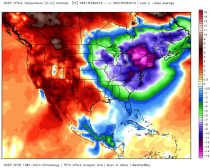
Enlarged
It reached -30F at Saranac Lake and -37F at Watertown in New York State and -40F on Mt. Washington with wind chills to -80F. Dozens of people were trapped for several hours on stalled tram cars on a snowy New Hampshire mountain Sunday, braving subzero temperatures while the cars dangled in mid-air before being rescued.
Even New York City dropped to -1F Sunday, coldest since 1994 with wind chills plunging below -30F. NYC cancelled their ice festival Sunday because it was too cold. Ironically last month they cancelled the Central Park Snow Festival because of too much snow.
For the 10 northeast states and DC, January to March in 2014 was the 11th coldest on record since 1895 (with March ranked coldest to second coldest here in northern New England). Last year, January to March was the all-time coldest (tied with 1904). February 2015 was the coldest month of any month in our part of New England in history and also the snowiest (100 inches in 39 days).
This year thanks to El Nino, the cold has been extreme but so far, episodic instead of more continuous and the record breaking January blizzard stayed just to our south.
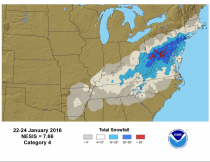
Enlarged
With the very warm December, temperatures for the meteorological winter of December to February will be above normal here in the northeast (though colder than normal to our south). However, January to March could again end up colder than normal here too, though it will not rank up there with the last two years.
I found the 60 year ago record broken interesting. We have a well-established 60-year cycle in weather, riding on many longer-term cycles related to behavior of the sun and oceans. This is much like the waves on the ocean riding on the longer swells. I have written about these in books and peer-reviewed papers. A change occurred 60 years ago, which I catalogued in my master’s thesis on east coast snowstorms. At that time cold and snow for a few decades suddenly became biased to the latter part of winter. That certainly has been the case the last three years.
At Weatherbell, we advised out clients most of the winter would come January to March, with the potential for significant cold outbreaks and more snowstorms.
Here, we will continue to ride the roller coaster into early next week, but then stronger cold returns again with more snow threats.
In the last El Nino in 2009/10, when the Mid-Atlantic received all-time record snows in what was called ‘Snowmageddon’, we in New England ended up near to below normal for snowfall. Though that may in the end happen this year, we will have numerous chances the next 5 to 6 weeks and one or more may track just right to bury ‘us’. If so, don’t blame me. I am just the messenger. Blame ‘Phil’.
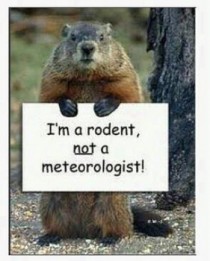
-----------
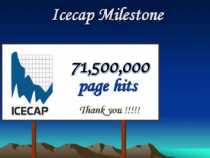
Help us maintain Icecap if you are able. Even small amounts help us pay the maintenance charges for the server that keep coming each month. We keep the site going without a support staff to try and provide you with information you can use. We have over 8000 entries searchable - to help you find the information you need. Alternatively, consider a subscription to Weatherbell.
|











